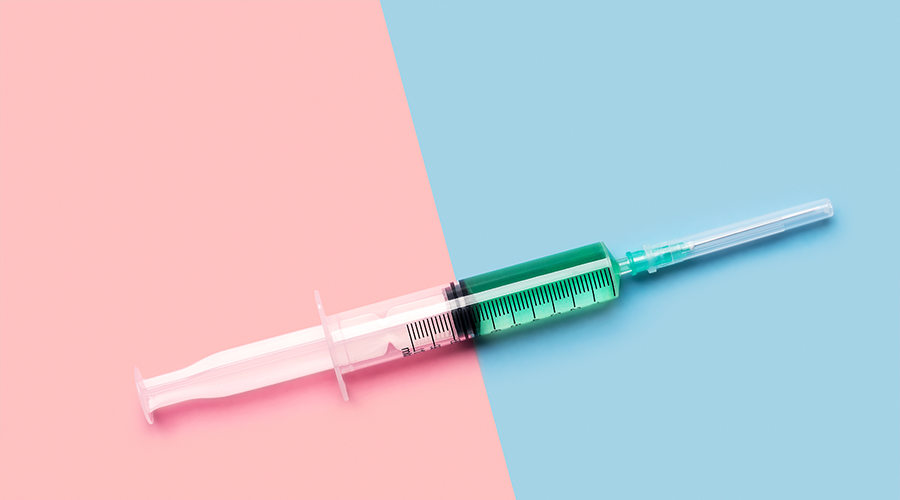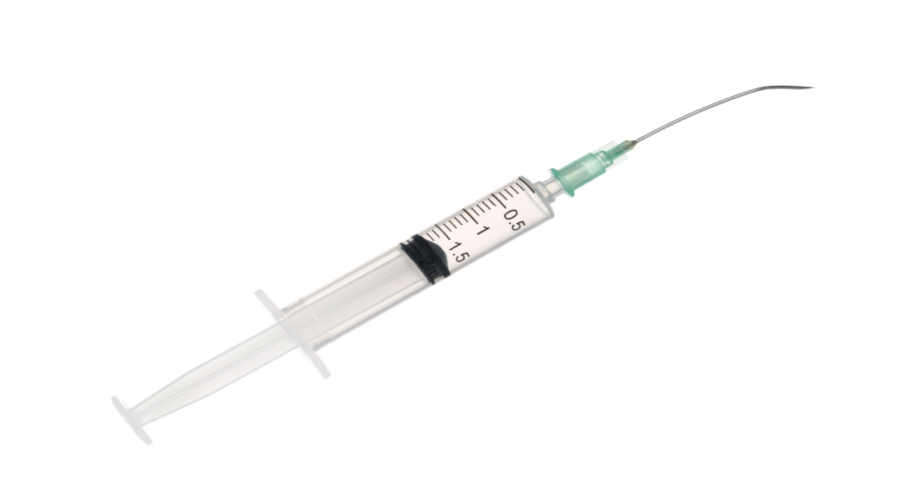When Beverly Schaefer became one of the first pharmacists to administer flu shots in 1996, she could never have guessed that twenty years later she’d be administering nearly thirteen thousand immunizations per year.
Schaefer says her pharmacy was the first in the U.S. to offer mass immunizations administered by a pharmacist, and the reason she pioneered the idea came down to a business problem. She had turned down a contract from a major payer and all at once she lost 300 patients. Searching for a way to retain their business even while they were getting their prescriptions somewhere else, she ordered the flu vaccine and posted a sign on her door.
“We were hoping to do 300 flu shots the first year,” she said. “We did 1,200. The biggest problem is that we had to go to the bank twice a day because we had so many tens and twenties in the till.”
At that time they gave the shots out of a backroom with a table and a couple of chairs. When people came in to get the shots, they kept asking what else the pharmacy was going to offer back there. “It was like a light bulb went off,” Schaefer said. “What people want is access to healthcare.” Now her pharmacy, Katterman’s Sand Point Pharmacy, has become a true immunization destination, offering 28 vaccines year-round. They account for nearly 20 percent of her business and 30 percent of her profit.
“If you want to add profit to your bottom line, increase the number of immunizations that you’re doing,” Schaefer said. “Every single immunization that you do adds to your bottom line. There are no exceptions.”
Marty Feltner, director of immunization services for Kohll’s Pharmacy, also pioneered immunization in his home state of Nebraska. As the first pharmacy in the state to offer immunizations, Kohll’s has become the immunization leader in the region. “It’s another added component to bring in another revenue stream,” Feltner said. “When you look at pharmacies today, they’re pretty much breakeven pharmacies. So in order to be positive, as far as revenue stream, you’ve got to think outside the box.” Among its eight locations, Kohll’s administers 50,000 to 80,000 flu immunizations per year.
Both Katterman’s and Kohll’s specialize in travel immunizations, which in itself has been a boon for business. People travel from hours away to get travel shots from their pharmacies. Around half of Schaefer’s total immunization revenue comes from travel vaccines.
They both believe immunizations have become essential to compete in today’s world, especially as a way to differentiate from online and mail-order pharmacies that are capturing more and more of the market share. “You know that [Bezos] family that sends boxes to every house every day across the country?” Schaefer said, whose pharmacy is in Seattle, the location of Amazon’s headquarters. “They have to come to my store to get travel immunizations. Because you can’t do that by mail. So why not offer a service that mail order will never be able to compete with?”
A Golden Opportunity
Around 100 million Americans get the flu shot every year, which produces around $4 billion to $5 billion in revenue. That’s just influenza. Each year, the national chain pharmacies and big-box stores battle to snatch up patients to their immunization programs with aggressive marketing and significant discounts.
Yet the immunization market is still largely untapped. A 2017 report from the Centers for Disease Control and Prevention stated that vaccination rates have a long way to go to meet the Healthy People 2020 goals. And pharmacies can be the prime beneficiaries of this growing demand. Surveys show that patients find pharmacies to be more accessible and convenient than physicians’ offices and health clinics. And the majority of people in the U.S. now prefer getting vaccinated at the pharmacy, according to
a survey by PrescribeWellness.
Many independent pharmacies have already caught on to this trend. The 2018 NCPA Digest shows 70 percent of pharmacies offering immunizations. However, that number includes pharmacies that only offer the flu shot. Another estimate says less than a quarter of independents offer immunizations beyond influenza. And the flu shot is only the tip of the immunization iceberg. There’s a glacial immunization opportunity beyond influenza waiting to be uncovered. For example, flu shots bring in roughly $20 of profit a pop. Compare that to meningococcal group B vaccine at $48, human papillomavirus at $50, and hepatitis B at $80, according to one estimate. An independent pharmacy in Louisiana earned nearly $6,000 in profit from only 70 shots of hep B in the first year of offering the vaccine.
“If you want to add profit to your bottom line, increase the number of immunizations that you’re doing. Every single immunization that you do adds to your bottom line. There are no exceptions.”
Multiple pharmacy experts say pharmacies that offer expanded immunizations can expect a minimum $40K per year in additional revenue, but more likely closer to $90K. One independent pharmacy in Oklahoma gave 1,800 vaccines in one year, earning $40K in pure profit. Another independent pharmacy in Pennsylvania averaged more than 700 immunizations in its second year, resulting in more than $16K in profit.
“You do two or three new consultations a day, your profit on just those consultations could potentially pay for that pharmacist just to be there that day,” Feltner said. “There are times where we’ll get five or seven consultations in one day and have profitability of three or four hundred dollars on just that one-hour appointment depending on the patient’s travel designation.”
Schaefer said the least amount of profit you’ll ever make on a vaccine is $15 to $20. You essentially get paid twice, once for the product and once for the service itself. “How many prescriptions do you make fifteen to twenty dollars on?”
Immunizations also provide additional business benefits to indirectly increase revenue and profitability. “What we’re finding is that pharmacies and pharmacists who are engaging in immunizations are being approached for other patient care activities,” said Mitch Rothholz, chief strategy officer for the American Pharmacists Association (APhA). “Coming in for immunizations is an opportunity to talk about other healthcare services they might need that the pharmacy can provide.”
That has been true in Feltner’s experience, especially for the shingles vaccine, which is suffering shortages because demand is so high. “You’re going to have lots of patients come into the pharmacy who may not be a regular customer and by offering the service you get them in the door,” he said. “If we say we offer the shingles vaccine, we may be able to transfer their prescription business over to our pharmacy just by having an immunization program. It just opens more doors.”
A broad and lasting benefit, immunizations move your pharmacy in the direction the profession is headed: from medication-focused to patient-focused care. “It’s a demonstration of pharmacists as a healthcare provider,” Rothholz said. “Because pharmacists are trying to move and expand their services into a more quality patient care delivery activity versus just providing a product. Pharmacists’ value to patients and the healthcare team is recognized when patients receive the appropriate medication or healthcare service and achieve the optimal benefit from those services.”
The addition of patient-centered services not only sets you up to survive the future of pharmacy, it also helps nurture patient loyalty. It’s one of the few opportunities pharmacists have to meet face-to-face with patients. “You’ll have a patient for life once you start immunizing,” Feltner said. “It’s been a very rewarding experience.”
Easy as 1, 2, 3
Many pharmacies don’t offer immunizations because the thought of an immunization program is overwhelming. After all, it’s a whole new addition that requires you to spend time and money ordering and storing new inventory, marketing new services, and most importantly, fitting it into your already busy workflow.
But Feltner and Schaefer said the difficulty of offering immunizations is a major misconception that keeps too many pharmacies away. In fact, adding an immunization program is really easy, they said.
You simply treat immunizations like prescriptions. When someone asks for an immunization, your process follows just as if they handed you a prescription. You give them a consent form, enter their insurance info, ring them up, and when they get to the front of the queue, the pharmacist brings them to the consultation room and administers the vaccine. “Doing an immunization takes about as much time as filling a new prescription,” Schaefer said. “It’s like entering a new patient.”
Vaccines are ordered from your primary wholesaler (or possibly direct from the manufacturer) and stored in your refrigerator with your insulins and other refrigerated medicine, or they’re stored in your freezer. In other words, they fit right in alongside all your other prescription medicines.
But the only way to make the integration seamless is to utilize your employees well. Every part of the process should be conducted by technicians except for reviewing the documentation and administering the vaccine, which doesn’t take more than a couple of minutes of the pharmacist’s time. If you have a pharmacist who’s a recent graduate, consider letting them take the reins. “They’ve been trained in college to do this,” Schaefer said. “Give it to the youngest one and let them be in charge of it if you trust them.”
Feltner suggests starting out slow, with the flu, shingles, and pneumonia vaccines, and working your way up from there. “You can get a vaccine program up and running very, very quickly,” he said. He and Schaefer both grew their immunization programs gradually, adding vaccines to their repertoire as patients requested them. She suggests trying to expand your program by 10 percent each year, which she promises is achievable. Eventually you may grow your pharmacy into a complete immunization destination. “It just has a way of continuing to grow if you’re doing a good job at it,” she said.
Before you get started, reach out to other health providers and public health staff in your community, Rothholz said. “Identify what are their and their patients’ needs and challenges related to immunizations that your pharmacy could help address.”
Six Steps to Get Your Program Off the Ground
1. Check laws and regulations
2. Get trained and certified
3. Talk to other providers to get buy-in, discover needs, and establish a CPA if necessary
4. Prepare the pharmacy: create a private space, train staff, order supplies, and put a sign on the door
5. Establish workflow
6. Market the service
Potential Challenges
The biggest obstacle to getting an immunization program off the ground will likely be the legal aspect. Although every state allows pharmacists to administer vaccines, scope of authority varies widely. “The variability in what pharmacists can administer is typically dependent upon the age of the patient, the type of antigens or vaccine, and some other procedural modifications,” Rothholz said.
In many states, you have to establish standing protocols or collaborative practice agreements to be able to vaccinate. Most states require pharmacists to complete training on pharmacy-based immunizations. Pharmacies and pharmacists can check with their state pharmacy association or state board of pharmacy to identify the requirements and restrictions related to immunizations before getting started, Rothholz said.
If you need an agreement or protocol, Schaefer recommends coming up with a plan to approach a provider. Choose your provider carefully, maybe starting with the health department. And when you go to make your case, make it all about the patient. “Always, always take the high road,” she said. “It’s about giving patients easy access to preventive care.”
Another potential hurdle you’ll want to be ready for is billing. Coverage for vaccines in pharmacies varies from plan to plan, including some under Medicare Part B and others through Part D. Some plans cover the total cost of the vaccine, others require a copay, and others don’t cover it at all. If a vaccine is not covered under the patient’s pharmacy benefit, Feltner and Schaefer have the patient pay out-of-pocket and self-submit the claim to their medical insurance. However, pharmacies can enroll as a mass-immunization provider and be compensated at the same level as physicians and other providers under Medicare Part B, Rothholz said.
For pharmacies feeling overwhelmed by the thought of starting a program, there are all kinds of resources to help. Start with the APhA’s certification program, which has trained more than 340,000 pharmacists. “The program is now considered the gold standard for pharmacy-based immunizations. It’s updated, it’s in line with CDC recommendations, it’s reviewed by immunization experts, and it’s recognized by individuals outside of the profession for its quality and content,” Rothholz said. In addition, APhA provides access to products and resources to keep up with current recommendations and vaccine information.
For clinical and logistical resources, visit the Immunization Action Coalition (IAC) website (www.immunize.org), which provides protocols, vaccine information statements, consent forms, and a host of other free documents as well as complete guidelines for offering immunizations at the pharmacy. Further resources for everything you need can be found from the APhA, CDC, and the Advisory Committee on Immunization Practices (ACIP).
More Than Profit
One of Feltner’s favorite parts of immunizations is the opportunity they provide to interact with patients. It’s one of the few things that frees him from behind the counter to get that personal touch.
Same goes for Schaefer. “Doing an immunization, it’s a very intimate and private moment,” she said. “You actually get to know these patients in a different way than you do transacting over the counter.”
Immunizations live in that sweet spot of pharmacy practice where healthier patients and a healthier business meet. Research overwhelmingly shows that when pharmacies vaccinate, uptake increases, outcomes improve, and healthcare costs decrease.
“The more often we vaccinate, the more chances we have to decrease disease,” Feltner said. “And that’s the whole goal is to vaccinate as many people as we can. And it’s a great feeling as a pharmacist to immunize someone against a potentially deadly disease.”
20 Tips to Make Your Immunization Program a Profit Center
Maximize your profit by increasing immunization sales with smart strategies from pharmacy owners who have been doing it for decades. Independent pharmacy owner Beverly Schaefer and director of immunization services Marty Feltner provide tens of thousands of immunizations every year, and their independent pharmacies have become immunization destinations. Use these tips compiled from their expertise and current research to get most money from your immunization program.
1. Start the Conversation
Starting the conversation is the most important part of increasing immunizations, Schaefer said. “There’s lots of topics that you can choose to start a conversation about immunization—travel, staying healthy, new vaccines. Even if people don’t do it right then, it plants a seed in their brain. And it gets word-of-mouth going.”
2. Put a Sign on the Door
For Schaefer, a simple sign is the first and most important step in marketing your services. This has been her single most successful strategy for increasing immunizations. On the sign, list all the immunizations you offer. “When we did this, people were totally amazed that we were doing all these shots,” she said.
3. Educate Patients
According to the CDC, education remains the largest barrier to immunization coverage. Simply informing patients about the preventable diseases and the vaccines that prevent them is an easy way to increase immunization rates. Use in-store signage, brochures from manufacturers, bag inserts, or a conversation.
4. Make Specific Recommendations
Asking the right patients about the right vaccines will give you a higher conversion rate. That involves identifying eligible patients and recommending the specific vaccine to them directly. For example, if the patient is over 50, simply let them know: Nearly 40 percent of people who have had chickenpox will get shingles. Offer to give them the vaccine right then and there.
5. Target Flu Shot Patients
Patients who get the flu shot have already shown an openness to immunizations, which means they’ll be much more inclined to accept further vaccines, according to a 2018 study published in Psychological Science in the Public Interest (PSPI). When patients come in for flu shots, have them fill out an intake form and ask about the last time they received other recommended vaccines.
6. Make Strong Recommendations
The PSPI study also discovered that a strong recommendation from the provider is the single most powerful way to motivate someone to get vaccinated. Instead of asking if they would like the vaccine, tell them they’re eligible and that they can get it before they leave the pharmacy.
7. Identify Eligible Patients
Most pharmacy systems allow you to create an alert for patients when their profile matches a vaccine need, which most often is based on age. Feltner relies on his employees to know which patients to look for and when to recommend vaccines. “The big key is to delegate and to train your staff on how to recognize someone who is eligible,” he said. “Train your staff. Train your staff. Train your staff.”
8. Utilize Entire Staff
After a visit to a national chain, Feltner realized how effective it is to have every single staff member, no matter their role, ask patients if they’ve gotten a vaccine. The store’s cashier asked every patient at checkout if they had gotten the flu shot. If they said no, she directed them to the pharmacy. “I thought that was eye opening,” he said. “That’s part of the whole idea of delegating to your entire staff.”
9. Zero Copay Tactic
This trick has been wildly successful for Feltner: He keeps track of which insurance and government plans offer patients a zero copay for a vaccine. Any time his staff sees a patient with one of those plans, they make the recommendation and let the patient know the vaccine is completely free. At that point, it’s an easy sell.
10. Co-administration
Co-administering vaccines can also cause an uptick in vaccinations. Patients will be much more likely to receive multiple immunizations if they get them all in one stop rather than returning at another time. As long as the vaccines don’t have contraindications, you can safely administer multiple vaccines in one visit. Also consider ordering combination vaccines that contain multiple vaccines in one shot, which are even more convenient for patients and reduce your storage costs.
11. Offsite Events
“Pharmacists who are successful in immunizations are not limiting provision of vaccines to the walls of their practice,” said Mitch Rothholz, chief strategy offer at APhA.“They’re going out to businesses and doing immunizations in the community, whether it be an event or in private businesses.” Offsite events not only generate money from vaccines given at the event, they’re also a perfect opportunity to recruit new patients to your pharmacy for good. Good offsite opportunities include school systems, health fairs, local businesses, assisted-living communities, apartment-complex communities, police departments, churches, and colleges.
12. Employer Partnerships
A huge source of immunization revenue for Feltner’s practice site is corporate partnerships. He’s developed relationships with several corporations who send their employees overseas. All of those employees go to Kohll’s Pharmacy for travel immunizations, which usually involve multiple vaccines.
13. On-Air Advertising
Go live on the radio or TV and give flu shots. “Just make it fun,” Feltner said. “The big thing I tell pharmacists is make it fun. Then you’re having fun immunizing and preventing disease.”
14. Helping with Costs
The second biggest barrier to immunizations, according to the CDC, is cost. The agency recommends pharmacies consult with local and state public health vaccination programs to learn about publicly funded programs that could help patients with the cost of vaccines. You can also enroll in the Vaccines for Children Program, which provides pharmacies federally purchased vaccines to fully vaccinate eligible children.
15. Offer Coupons
Take a page from the national chain pharmacies and big-box stores. Give patients a small voucher or coupon to your front end when they get an immunization from you. The profit you earn from them will outweigh the gift.
16. Fax Physicians
After immunizing a patient, Schaefer sends a fax to the provider. The fax includes the entire list of vaccines she offers, with an X next to the vaccine she administered. That way, the physician will know every vaccine she offers and can refer patients to her in the future.
17. Word-of-Mouth
If you offer a top-notch immunization program, your patients and physicians will do the advertising for you. Both Schaefer and Feltner attributed their most successful marketing to word-of-mouth. In fact, Schaefer spends zero dollars on advertising.
18. Answering Machine
Use your answering machine to highlight your immunization services. “When you call my store, it’s ‘Hello, you’ve reached Katterman’s pharmacy, your immunization destination,’” Schaefer said. “That way they’re thinking about immunizations whether they want to or not.”
19. Incentivize Your Pharmacists
Schaefer said the high margins on immunizations allow you to pay a bonus to your pharmacists for each immunization they administer. For an immunization that earns $20, let your pharmacists take two to five bucks of that to give them extra motivation.
20. Travel Tricks
Travel vaccinations come with their own bag of tricks—all of which genuinely help the health of patients.
- Hold a consultation with patients to ask where they’re going, review their immunization history, and offer them everything they’ll need.
- Use Travax, an online resource, to identify every vaccine a patient will need for the area they’re visiting.
- Create a “travel checklist” with OTC items patients may need for the trip, which they can purchase in your front end.
- Compile a section in the front end dedicated solely to travel products and walk your patient through it after each consultation. Schaefer said it’s not uncommon for patients to spend an extra one to two hundred dollars on her OTC travel products.
- Put a sign on your front door: “Are you traveling out of the country? Have you had your hep A, yellow fever, and typhoid shots?”
- If a patient comes in asking for a specific travel vaccination, ask where they’re traveling. You may be able to offer additional immunizations or travel products.
- Get a standing order or collaborative practice agreement to administer prescription travel medicine, like antimalarial drugs.
From the Magazine
This article was published in our quarterly print magazine, which covers relevant topics in greater depth featuring leading experts in the industry. Subscribe to receive the quarterly print issue in your mailbox. All registered independent pharmacies in the U.S. are eligible to receive a free subscription.
Read more articles from the March issue:
- How CPESN networks break pharmacies into the lucrative side of healthcare
- A classic retail tactic that boosts front-end sales
- Is pharmacist prescribing authority on the rise?
- This pharmacy dramatically expanded its business through telepharmacy
- How to hire the best people for your pharmacy
- A new weight loss program that helps patients lose pounds
A Member-Owned Company Serving Independent Pharmacies
PBA Health is dedicated to helping independent pharmacies reach their full potential on the buy-side of their business. Founded and owned by pharmacists, PBA Health serves independent pharmacies with group purchasing services, wholesaler contract negotiations, proprietary purchasing tools, and more.
An HDA member, PBA Health operates its own NABP-accredited secondary wholesaler with more than 6,000 SKUs, including brands, generics, narcotics CII-CV, cold-storage products, and over-the-counter (OTC) products — offering the lowest prices in the secondary market.












